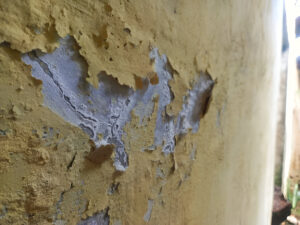Navigating the murky waters of home safety can be daunting, especially when it comes to lead paint. You’re probably wondering, ‘Can my kids live in a house with lead paint safely?’
Let’s unravel this tangled issue together, exploring the health risks, identifying lead paint in your home, and understanding the necessary safety measures and remediation techniques.
It’s time to clear the air and ensure your home is a safe haven for your little ones.
Understanding Lead Paint
To understand the potential risks, you’ve got to know what lead paint is and why it’s harmful. Lead-based paint is a major source of lead exposure. It’s hazardous because, when it peels or is disturbed, tiny particles of lead are released. Ingesting or inhaling these particles can result in lead poisoning, especially in children.
It’s worth noting that most homes built before 1978 have some lead-based paint due to the lack of paint legislation. It wasn’t until this year that the U.S government banned consumer uses of lead-containing paint. Knowing the paint legislation history helps you identify potential lead exposure sources in your home.
Health Risks for Children
Often, you’re not aware of the serious health risks your child can face when living in a house with lead paint. Lead toxicity can significantly impact childhood development, causing irreversible damage. Here are some potential health risks:
- Neurological Effects: Lead can damage a child’s nervous system, leading to behavioral problems and learning difficulties.
- Physical Growth Delays: Lead toxicity can interfere with a child’s growth and development, causing delays in physical and cognitive milestones.
- Hematological Problems: Chronic lead exposure can affect the body’s ability to make hemoglobin, leading to anemia.
It’s crucial to understand these risks and take necessary precautions like Lead Paint Testing and Lead Water Testing. By doing so, you can ensure a safe and healthy environment for your child.
Safety Measures in Lead Paint Homes
Understanding the risks, you’re probably wondering how you can protect your child if you’re living in a home with lead paint.
First, always use protective clothing when dealing with lead paint. This includes gloves, masks, and coveralls to prevent direct contact with the substance.
Second, consider paint alternatives. Low-VOC and lead-free paints are safer choices for your home. If removal isn’t an option, you can also use encapsulants, special coatings that seal the lead paint, preventing it from releasing harmful particles.
Lastly, ensure regular cleaning of your home. Dust and paint chips can contain lead, so frequent sweeping, mopping, and washing can mitigate exposure.
Always remember, your child’s safety is paramount- taking these precautions can significantly reduce their exposure to lead.
Also read: Dangers of Lead Exposure at Workplace
Identifying Lead Paint in Your Home
Regularly checking your home for signs of lead paint is just as crucial as taking safety measures, since early detection can help you take the appropriate steps to safeguard your family. Here’s how you can identify lead paint in your home:
- Lead Paint Testing: Peeling or cracking of old paint is a red flag. You should also be wary of dust from deteriorating paint.
- Detection Equipment Usage: Invest in a lead paint test kit or hire a professional who uses advanced detection equipment for accurate results.
- Note the Age of Your Home: Houses built before 1978 are more likely to have lead-based paint.
Remediation and Lead Paint Removal
If you’ve discovered lead paint in your home, it’s crucial that you don’t panic but promptly take steps toward remediation and lead paint removal.
Start with a cost evaluation to understand the financial implications. This involves assessing the size and severity of the lead contamination.
Then, seek professional assistance. Trained experts can safely eliminate the risk, using methods such as encapsulation or complete removal. They’ll ensure the lead dust, which poses a significant health risk, especially to children, is properly contained and disposed of.
It’s vital to remember that DIY lead paint removal can be perilous, as you might inadvertently release toxic lead dust. So, always rely on professionals for a thorough and safe lead paint removal process.
Conclusion
In conclusion, while you can let your kids live in a house with lead paint, it’s not without its risks. Remember the adage, ‘an ounce of prevention is worth a pound of cure.’
Make sure to identify and tackle any lead paint issues head-on to safeguard your little ones’ health. It’s not just about maintaining a beautiful home—it’s about creating a safe, healthy environment where your children can grow and thrive.




